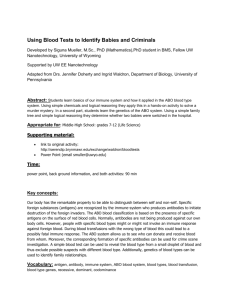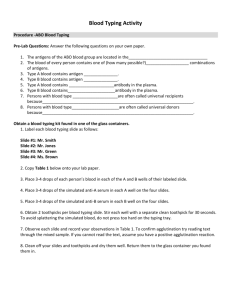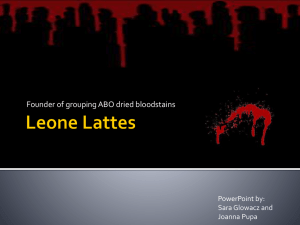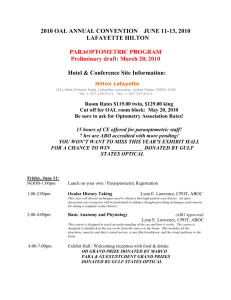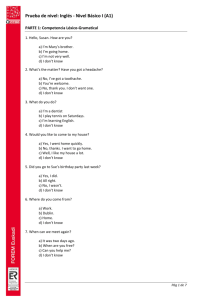Use Blood Types to Help Solve a Crime
advertisement
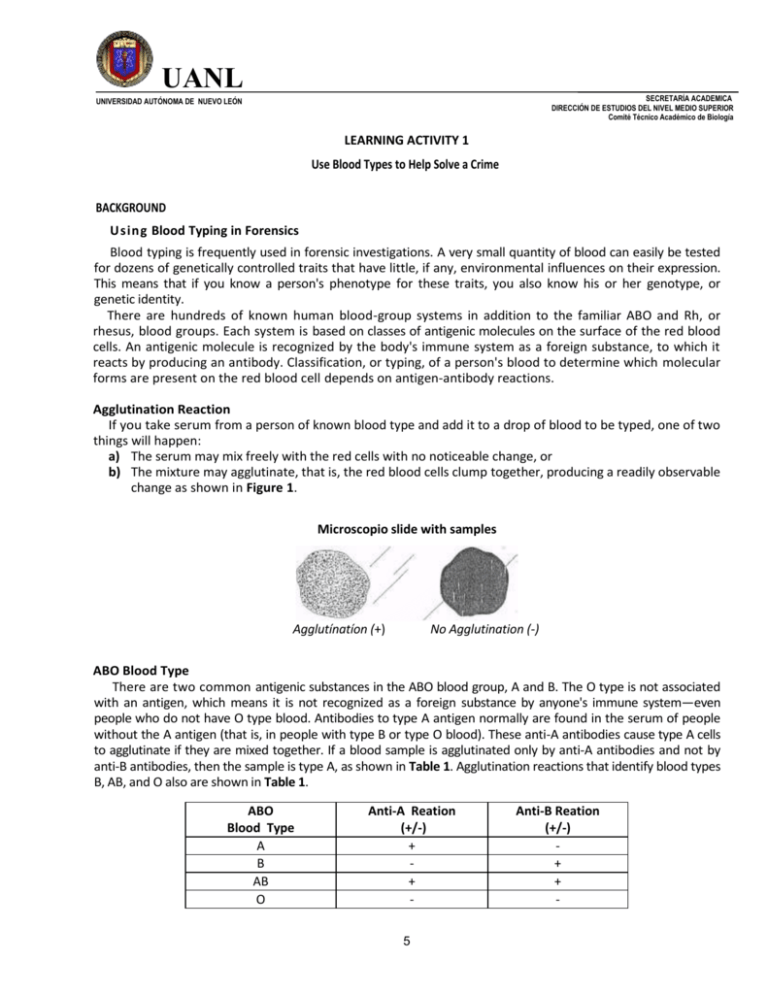
UANL SECRETARÍA ACADEMICA DIRECCIÓN DE ESTUDIOS DEL NIVEL MEDIO SUPERIOR Comité Técnico Académico de Biología UNIVERSIDAD AUTÓNOMA DE NUEVO LEÓN LEARNING ACTIVITY 1 Use Blood Types to Help Solve a Crime BACKGROUND Using Blood Typing in Forensics Blood typing is frequently used in forensic investigations. A very small quantity of blood can easily be tested for dozens of genetically controlled traits that have little, if any, environmental influences on their expression. This means that if you know a person's phenotype for these traits, you also know his or her genotype, or genetic identity. There are hundreds of known human blood-group systems in addition to the familiar ABO and Rh, or rhesus, blood groups. Each system is based on classes of antigenic molecules on the surface of the red blood cells. An antigenic molecule is recognized by the body's immune system as a foreign substance, to which it reacts by producing an antibody. Classification, or typing, of a person's blood to determine which molecular forms are present on the red blood cell depends on antigen-antibody reactions. Agglutination Reaction If you take serum from a person of known blood type and add it to a drop of blood to be typed, one of two things will happen: a) The serum may mix freely with the red cells with no noticeable change, or b) The mixture may agglutinate, that is, the red blood cells clump together, producing a readily observable change as shown in Figure 1. Microscopio slide with samples Agglutínatíon (+) No Agglutination (-) ABO Blood Type There are two common antigenic substances in the ABO blood group, A and B. The O type is not associated with an antigen, which means it is not recognized as a foreign substance by anyone's immune system—even people who do not have O type blood. Antibodies to type A antigen normally are found in the serum of people without the A antigen (that is, in people with type B or type O blood). These anti-A antibodies cause type A cells to agglutinate if they are mixed together. If a blood sample is agglutinated only by anti-A antibodies and not by anti-B antibodies, then the sample is type A, as shown in Table 1. Agglutination reactions that identify blood types B, AB, and O also are shown in Table 1. ABO Blood Type A B AB O Anti-A Reation (+/-) + + 5 Anti-B Reation (+/-) + + - UANL SECRETARÍA ACADEMICA DIRECCIÓN DE ESTUDIOS DEL NIVEL MEDIO SUPERIOR Comité Técnico Académico de Biología UNIVERSIDAD AUTÓNOMA DE NUEVO LEÓN Rhesus Blood Type Rhesus blood types have only one common antigen associated with them. It is often referred to as antigen D. Blood from people with the D antigen (Rh+) is agglutinated by anti-D antibodies, which may be found in the blood of people without the antigen (Rh-). Agglutination reactions that identify Rhesus blood types are shown in Table 2. Rhesus Blood Type Rh+ Rh- Anti-D Reaction (+/-) + - THE PROBLEM Some school property was vandalized, and a few drops of blood were found at the scene of the crime. The detectives investigating the incident think that the blood came from the perpetrador of the crime, who apparently was slightly injured during the vandalism. The detectives have gathered a group of suspects who were all on school property when the crime was committed. However, the only hard evidence is the blood found at the scene. The detectives want to rule out as many of the innocent suspects as possible on the basis of the blood evidence. In this lab, you will act as a lab technician, analyzing a sample of blood from a suspect to determine tha blood type. Each one of your classmates will analyze a sample from a different suspect. Then, you and your classmates will compare the blood types of your samples with the type of the blood found at the crime scene in order to narrow down the field of suspects. MATERIALS ABO/Rh blood-typing test kit (with artificial or aseptic blood samples) Protective gloves Pieces of cotton Lancets Microscopio slides Magnifying glass Paper towels 10% bleach solution 6 UANL SECRETARÍA ACADEMICA DIRECCIÓN DE ESTUDIOS DEL NIVEL MEDIO SUPERIOR Comité Técnico Académico de Biología UNIVERSIDAD AUTÓNOMA DE NUEVO LEÓN SAFETY MEASURES In this lab, you will work with artificial or aseptic blood samples obtained from your teacher. Handle and dispose of the samples as instructed by the testing kit or your teacher or the bloodtyping test kit. Be sure to keep your hands away from your eyes and face in the science lab. Remember to wash your hands thoroughly before and after completing the lab procedure. Dispose of anything with blood on it immediately after use, according to your teacher's instructions. Wipe down your work surface with the bleach solution and paper towels. PROCEDURE 1. Obtain an ABO/Rh blood-typing test kit from your teacher. 2. Pay attention to your teacher´s instructions. 3. Obtain the blood sample from your teacher. Perform the ABO/Rh test as instructed by the kit. 4. Observe the samples and compare them with Figure 1. Record the results, positive or negative for each reaction, in columns 1-3 of Table 3 under Data and Observations on the section Personal Data. 5. Record the data of you team partners on Table 3, in the section Team Data. Record all the information as you did it with you personal samples. 6. Refer to Tables 1 and 2 to determine ABO and Rh blood types based on the agglutination reactions. 7. Record the ABO and Rh blood types in column 4 of Table 3. 8. Notify your teacher of your results. 7 UANL SECRETARÍA ACADEMICA DIRECCIÓN DE ESTUDIOS DEL NIVEL MEDIO SUPERIOR Comité Técnico Académico de Biología UNIVERSIDAD AUTÓNOMA DE NUEVO LEÓN Observations Table-3 OBSERVATIONS 1 Anti-A Reaction (+/-) 2 Anti-B Reaction (+/-) 3 Anti-D Reaction (+/-) 4 ABO/Rh Blood Type Personal Data Team Data Conclude and Apply 1. Your teacher will tell you the number of suspects of each blood type. The type of blood found at the crime scene is A+. Based on this information, how many suspects can be ruled out as possible perpetrators of the crime? __________________________________________________________________________________ __________________________________________________________________________________ 2. Explain why blood types can be used only to rule out potential suspects and not to prove conclusively who committed a crime. __________________________________________________________________________________ __________________________________________________________________________________ __________________________________________________________________________________ __________________________________________________________________________________ 8 UANL SECRETARÍA ACADEMICA DIRECCIÓN DE ESTUDIOS DEL NIVEL MEDIO SUPERIOR Comité Técnico Académico de Biología UNIVERSIDAD AUTÓNOMA DE NUEVO LEÓN 3. If you could test for other blood-group types in addition to AEO and Rh, how might this affect the investigation? _________________________________________________________________________________ _________________________________________________________________________________ _________________________________________________________________________________ 4. All of the ABO/Rh blood types are relatively common in Monterrey, Mexico. The most common, O+, occurs in 63.1% of the population. The other statistics of blood type are: AB+ in 1.4% of the population, A+ (the one found at the crime scene) in 26.5% of the population and B+ in 9.0%. Some blood-group systems do not show as much variation, and only a small percentage of people do not have the same blood type. How useful would a less variable blood-group system be for forensic analysis? (Mexican Public Health statistic information, vol. 4, Number 5, Sep/Oct, 2002) __________________________________________________________________________________ __________________________________________________________________________________ __________________________________________________________________________________ __________________________________________________________________________________ __________________________________________________________________________________ __________________________________________________________________________________ 9 UANL SECRETARÍA ACADEMICA DIRECCIÓN DE ESTUDIOS DEL NIVEL MEDIO SUPERIOR Comité Técnico Académico de Biología UNIVERSIDAD AUTÓNOMA DE NUEVO LEÓN 10
